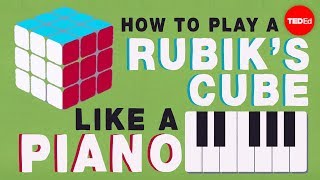(单词翻译:单击)
How can you play a Rubik's Cube?
你怎样玩魔方呢?
Not play with it, but play it like a piano?
我指的不是简单地摆弄它,而是像弹钢琴一样“演奏”它。
That question doesn't make a lot of sense at first,
这个问题起初看起来不符合常理,
but an abstract mathematical field called group theory holds the answer, if you'll bear with me.
但在一个被称为“群论”的抽象数学领域中有这个问题的答案,容我好好解释。
In math, a group is a particular collection of elements.
在数学中,一个“群”指的是一些元素的特定集合。
That might be a set of integers, the face of a Rubik's Cube, or anything,
可能是一组整数,或是魔方的面,亦或是任何东西,
so long as they follow four specific rules, or axioms.
只要他们符合特定的四条原则,或公理。
Axiom one: all group operations must be closed or restricted to only group elements.
公理一:群的所有“动作”必须仅限于组内的元素。
So in our square, for any operation you do,
在图中的框里,你所做的任何操作,
like turn it one way or the other, you'll still wind up with an element of the group.
比如将其转向一个方向,得到的最终结果仍是组内的一个元素。
Axiom two: no matter where we put parentheses when we're doing a single group operation, we still get the same result.
公理二:当我们在对群做一个操作时,无论我们在哪里加括号,结果都不会变化。
In other words, if we turn our square right two times, then right once,
换种说法,如果我们把魔方的一个面向右转动两次,再向右转动一次,
that's the same as once, then twice, or for numbers, one plus two is the same as two plus one.
这和先向右转动一次再转动两次得到的结果是一样的,从数字上来说,就像一加二等于二加一。
Axiom three: for every operation, there's an element of our group called the identity.
公理三:针对每一个操作,组中都有一个元素被称为“单位元”。
When we apply it to any other element in our group, we still get that element.
当我们将其特征赋予组中任何一个元素,我们仍然得到原来的那个元素。
So for both turning the square and adding integers, our identity here is zero, not very exciting.
针对于魔方的面和整数这两个组合,他们的单位元都是0,听起来并不是挺令人激动。
Axiom four: every group element has an element called its inverse also in the group.
公理四:群组中的任何一个元素都能在同一群组中找到一个“逆元”。
When the two are brought together using the group's addition operation,
当这两个相反的元素相加后,
they result in the identity element, zero, so they can be thought of as cancelling each other out.
得到的结果是单位元(零),所以可以说他们抵消对方。
So that's all well and good, but what's the point of any of it?
这就是四条针对群组的公理,可是意义在哪里呢?
Well, when we get beyond these basic rules, some interesting properties emerge.
当我们越过这些四条基本的规则,一些有趣的现象就涌现了出来。

For example, let's expand our square back into a full-fledged Rubik's Cube.
举个例子,我们把方块拓展至一个标准的魔方。
This is still a group that satisfies all of our axioms, though now with considerably more elements and more operations.
这是一个符合我们所有公理的“群”--尽管我们现在有了相当多的元素,以及更多的操作选择。
We can turn each row and column of each face.
我们可以转动每一面的各行各列。
Each position is called a permutation, and the more elements a group has, the more possible permutations there are.
每一种不同的情况叫做一种排列,当群中的元素越多,可能的排列就越多。
A Rubik's Cube has more than 43 quintillion permutations, so trying to solve it randomly isn't going to work so well.
一个魔方拥有超过43×10的21次幂种排列可能。所以尝试胡乱地解开它可行不通。
However, using group theory we can analyze the cube
然而,我们可以利用群论来分析魔方,
and determine a sequence of permutations that will result in a solution.
然后尝试找出一组特定的排列最终来解开魔方。
And, in fact, that's exactly what most solvers do, even using a group theory notation indicating turns.
事实上,这正是大多数复原魔方的人所干的事,他们甚至用一种群论标记来记录转动的次数。
And it's not just good for puzzle solving.
群论不仅仅局限于解开谜题。
Group theory is deeply embedded in music, as well.
群论也被深深地嵌入音乐中。
One way to visualize a chord is to write out all twelve musical notes and draw a square within them.
把一个和弦可视化的方法之一是写出全部十二个音符,并使他们围成一圈。
We can start on any note, but let's use C since it's at the top.
我们可以从任何一个音符开始,比如从最上边的C开始。
The resulting chord is called a diminished seventh chord.
所得到的和弦叫做“减七和弦”。
Now this chord is a group whose elements are these four notes.
这个和弦是一个由这四个音符元素组成的群。
The operation we can perform on it is to shift the bottom note to the top.
我们所能对其进行的操作是将最底部的音符放置到最顶端。
In music that's called an inversion, and it's the equivalent of addition from earlier.
在音乐中,我们称之为“转位”,这与我们之前所做的加法是等价的。
Each inversion changes the sound of the chord, but it never stops being a C diminished seventh.
每一个转位都改变了和弦的声音,但它一直是减七和弦。
In other words, it satisfies axiom one.
换句话说,它符合公理一。
Composers use inversions to manipulate a sequence of chords and avoid a blocky, awkward sounding progression.
作曲家们用和弦转位来操作一个和弦序列,用于避免不匀称或是不和谐的和声。
On a musical staff, an inversion looks like this.
在乐谱上,和弦转位看起来是这样。
But we can also overlay it onto our square and get this.
但我们还可以将其覆盖在这些方块上。
So, if you were to cover your entire Rubik's Cube with notes
如果你将整个魔方都赋予音符,
such that every face of the solved cube is a harmonious chord,
每一面复原后的魔方都是和声的和弦,
you could express the solution as a chord progression
将解魔方的步骤以“和声的进行”的形式表现出来,
that gradually moves from discordance to harmony and play the Rubik's Cube, if that's your thing.
音色会逐渐地由不和谐转为悦耳,“演奏”魔方吧!如果你喜欢的话。


